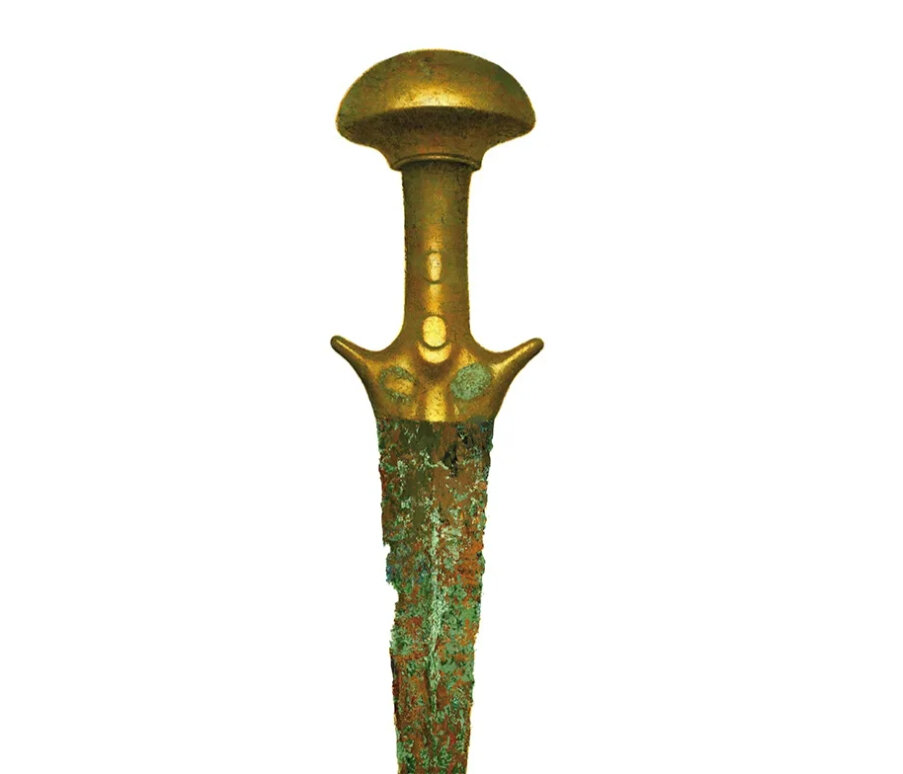Unveiling the tales of the past is often a task of connecting hidden threads. In this light, the Griffin Warrior grave in Pylos, Greece, reveals an intriguing tale of combat and craftsmanship in the Aegean Bronze Age. A key thread that connects the Griffin Warrior to the Minoans is the bronze sword with a gold pommel found in his grave—a weapon strikingly similar to that wielded by a warrior depicted on the Pylos Combat Agate.
THE GRIFFIN WARRIOR AND HIS GRAVE
Unearthed in 2015, the grave of the Griffin Warrior, so named for the mythical beast depicted on an ivory plaque found with the burial, dates back to around 1450 B.C. The tomb is of immense archaeological significance due to the remarkable preservation of the rich collection of grave goods.Among the multitude of artifacts discovered, a bronze sword with a gold pommel stands out. The sword’s ornate construction and precious metal adornment suggest that it was the possession of a high-ranking warrior or a nobleman.
University of Cincinnati/Pylos Excavations
THE MINOAN CONNECTION: THE HORNED HILT SWORD
The sword found in the Griffin Warrior’s tomb is not just any weapon; it is a Minoan-type sword with a distinctive horned hilt. This immediately draws parallels with Minoan Crete, an advanced civilization renowned for its art, architecture, and metalwork.The Minoans had a particular style of sword-making that distinguished their weaponry from others of the Bronze Age. The key distinguishing feature is the ‘horns, or projections, at the base of the hilt, forming a sort of guard for the hand. Such horned hilts are prevalent in depictions of warriors in Minoan art and have been found in archaeological contexts across Crete.

Well preserved Ci and Cii Types sword from Crete.
THE PYLOS COMBAT AGATE
Interestingly, this Minoan-type sword with a horned hilt makes a significant appearance in a tiny but highly detailed seal stone discovered within the Griffin Warrior’s tomb. This seal stone, known as the Pylos Combat Agate, depicts a fierce combat scene.A warrior on the Agate, presumably the Griffin Warrior himself, is portrayed as having already defeated one opponent and turning to engage another. In his hand, he wields a sword that bears a striking resemblance to the bronze sword with the gold pommel found in the tomb.

CONNECTING THE DOTS
This correlation between the Minoan-type sword found in the Griffin Warrior’s grave and the one depicted on the Pylos Combat Agate hints at a profound connection. It reflects a shared culture, or at least a strong cultural influence, between the Mycenaeans and the Minoans during the Late Minoan period.The presence of a Minoan-type sword in the Mycenaean warrior’s grave suggests that either the Griffin Warrior was of Minoan origin or, more likely, that he had strong connections with the Minoan culture. Perhaps he traded with them, fought with or against them, or admired their craftsmanship enough to acquire such a weapon.The parallels also underline the significance of swords during the Aegean Bronze Age. As symbols of power and status, they were part of the identity of the warrior elite. The fine craftsmanship and the use of precious materials for this particular sword show how high-ranking warriors in the Late Bronze Age Aegean sought to enhance their prestige and project their power through their weapons.

Found among the Griffin Warrior’s many grave goods, the Combat Agate depicts a scene among three warriors. Two are locked in deadly combat and one has fallen to the ground.PHOTOGRAPH BY J. VANDERPOOL, DEPARTMENT OF CLASSICS, UNIVERSITY OF CINCINNATI
The Griffin Warrior and the Minoan-type sword with a horned hilt form an intriguing archaeological puzzle. Their shared presence in the grave and the depiction on the Pylos Combat Agate speak volumes about the interconnectedness of the Aegean world during the Bronze Age. It is a fascinating tale of warriors, craftsmen, and civilizations woven through the lens of archaeology, revealing the splendors and complexities of our human past.

